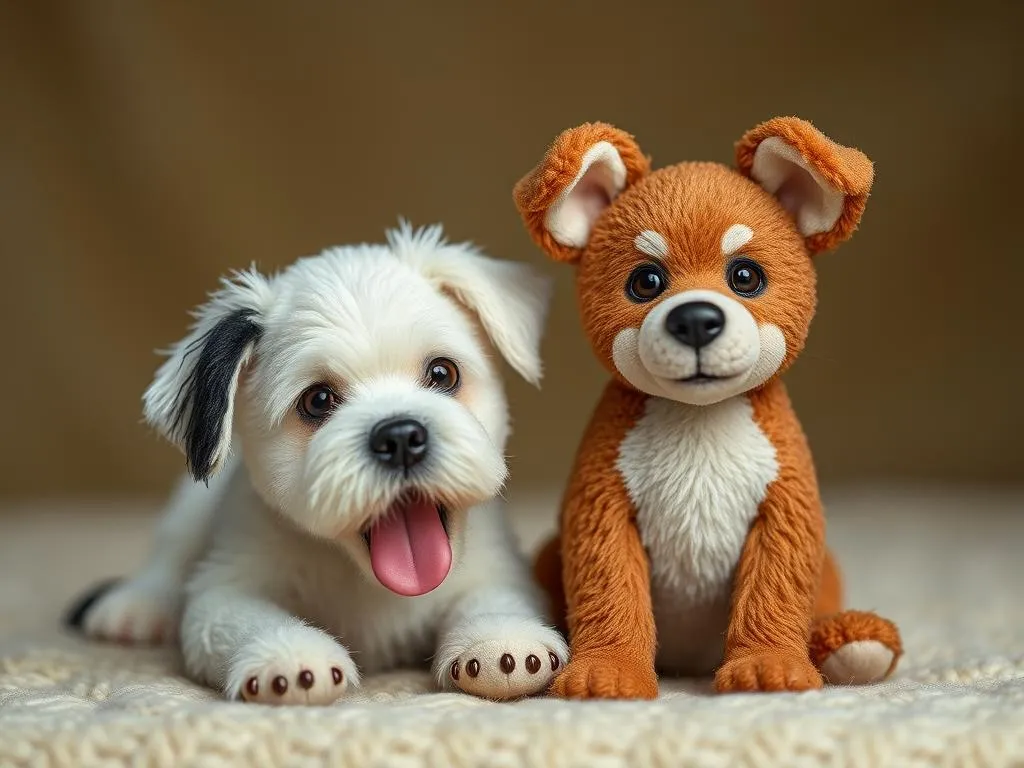
Introduction
Dogs are not just pets; they are cherished members of our families. As pet owners, we often find ourselves fascinated by our dogs’ interactions with various toys, particularly stuffed animals. This raises an intriguing question: do dogs think their stuffed animals are real? Understanding the behavior of our canine companions, especially in relation to their toys, can provide valuable insights into their cognitive processes and emotional well-being.
The importance of this topic extends beyond mere curiosity. Many pet owners are eager to understand their dogs’ perceptions of the world around them, especially when it comes to playtime, training, and emotional health. Recognizing how dogs interact with their stuffed animals can inform better approaches to training methods and enhance the overall bond we share with our furry friends.
In this article, we will explore the dynamics of canine cognition, the appeal of stuffed animals, and whether dogs perceive these toys as real beings. We will also examine the implications for dog owners in selecting toys and engaging their dogs meaningfully.
Understanding Canine Cognition
Basics of Dog Intelligence
To comprehend how dogs interact with stuffed animals, it’s essential to first understand canine intelligence. Dogs possess various types of intelligence, which can be categorized into three primary types: social, instinctive, and adaptive intelligence. Social intelligence refers to their ability to communicate and form bonds with humans and other animals. Instinctive intelligence includes their innate abilities, such as hunting or herding, while adaptive intelligence relates to a dog’s capacity to learn from their environment and experiences.
Dogs are known for their impressive problem-solving skills and emotional intelligence, which allows them to read human emotions and respond appropriately. This multifaceted intelligence plays a significant role in how dogs perceive and interact with their toys, including stuffed animals.
Perception and Sensory Processing
Dogs experience the world differently than humans, primarily through their acute senses. Their sense of smell is particularly powerful—estimated to be between 10,000 to 100,000 times more sensitive than that of humans. This remarkable olfactory ability allows dogs to gather detailed information about their environment, including the smells associated with their stuffed animals.
Sight and sound also contribute to a dog’s perception. Dogs are more sensitive to motion than to color, which means they may not distinguish between a brightly colored stuffed animal and a dull object in the same way a human would. Instead, their perception of toys is largely influenced by their texture, sound (such as squeakers), and scent.
Dogs and Their Stuffed Animals
The Appeal of Stuffed Animals to Dogs
So why are dogs so drawn to stuffed animals? There are several key features that make these toys appealing to our canine companions.
- Texture: Many dogs enjoy the soft, plush fabric of stuffed animals, which mimics the textures they might find in nature.
- Squeakers: The sound of a squeaker can be irresistible to dogs, triggering a natural hunting instinct that encourages play.
- Familiar Shapes: Stuffed animals often resemble small animals, which may stimulate a dog’s instinctual behaviors, such as chasing or chewing.
These features create an engaging play experience for dogs, making stuffed animals not only toys but also companions during their downtime.
Common Behaviors with Stuffed Animals
Dogs exhibit a range of behaviors when interacting with their stuffed animals. Some of the most common behaviors include:
- Play behaviors: Dogs may engage in fetching, tugging, or shaking their stuffed animals vigorously. These activities allow them to express their natural instincts and engage in physical exercise.
- Affectionate behaviors: Many dogs display affection towards their stuffed animals by cuddling, carrying them around, or grooming them. This behavior suggests an emotional connection that goes beyond mere play.
These interactions provide insight into how dogs perceive their stuffed animals and the emotional roles these toys play in their lives.
Do Dogs Perceive Stuffed Animals as Real?
The Argument for Realism
The question of whether dogs think their stuffed animals are real beings has sparked much debate among dog owners and researchers alike. Anecdotal evidence suggests that many dogs treat their stuffed animals as if they were living creatures. For instance, some dogs may protect their toys, display jealousy if another pet approaches them, or even engage in nurturing behaviors, such as carrying their stuffed animal gently.
Studies have indicated that dogs have a certain level of attachment to their toys, which could be interpreted as perceiving them as real companions. The way dogs engage with their stuffed animals often mirrors their interactions with other dogs, suggesting an innate response to these toys that transcends mere object recognition.
The Argument for Object Recognition
On the other hand, some experts argue that dogs may not perceive stuffed animals as real entities but rather as inanimate objects. This perspective suggests that while dogs enjoy playing with their toys, they understand the difference between living beings and objects.
Research on canine cognition indicates that dogs are adept at recognizing different types of objects and associating them with various actions. For example, a dog may learn that a ball is for fetching, while a stuffed animal is for cuddling. This understanding could imply that dogs are capable of distinguishing between the two, leading to different behaviors based on the type of toy.
The Role of Imagination and Play
Play as a Learning Tool
Play is a critical component of a dog’s development and socialization. Engaging with stuffed animals allows dogs to practice essential skills, such as problem-solving, social interaction, and impulse control. Through imaginative play, dogs can simulate hunting, nurturing, and other instinctual behaviors, which contribute to their overall cognitive growth.
Stuffed animals also serve as tools for dogs to express their emotions and relieve stress. When a dog engages in playful behavior with a stuffed animal, they experience joy and excitement, which can enhance their emotional well-being.
Emotional Connection to Toys
The bond between dogs and their stuffed animals can be profound. Many dogs develop attachments to specific toys, treating them as companions. This emotional connection can provide comfort during stressful situations, such as thunderstorms or when left alone at home.
For instance, a dog may carry their stuffed animal to their bed, snuggle with it, or even “protect” it from perceived threats. These behaviors indicate that stuffed animals can play a vital role in a dog’s emotional landscape, offering companionship and security.
Practical Implications for Dog Owners
Choosing the Right Stuffed Animals
When selecting stuffed animals for your dog, consider their size, chewing habits, and preferences. Here are some tips for choosing the right toys:
- Size: Choose stuffed animals that are appropriately sized for your dog. A small toy may pose a choking hazard for larger breeds, while oversized toys may be difficult for smaller dogs to handle.
- Material: Opt for durable materials that can withstand rough play. Look for toys specifically designed for dogs, as these are often more resilient than regular stuffed animals.
- Safety: Ensure that the stuffed animal is free from harmful chemicals or small parts that could pose a choking hazard.
Enhancing Playtime with Stuffed Animals
To make playtime more engaging, consider the following creative ideas:
- Interactive games: Incorporate games like hide-and-seek, where you hide the stuffed animal for your dog to find. This stimulates their problem-solving skills and provides mental exercise.
- Training sessions: Use stuffed animals as rewards during training, encouraging your dog to associate positive experiences with their toys.
Understanding Your Dog’s Behavior
As a dog owner, observing your dog’s interactions with their stuffed animals can provide valuable insights into their emotional state and preferences. Look for signs of attachment or distress, such as:
- Carrying the toy around: Indicates a strong bond or sense of comfort.
- Protective behavior: May suggest that your dog views the stuffed animal as a companion.
- Signs of stress: If your dog shows signs of anxiety when a toy is removed, it may indicate a deeper emotional reliance on the stuffed animal.
Understanding these behaviors can help you provide better care and emotional support to your dog.
Conclusion
In summary, the question of whether dogs think their stuffed animals are real is complex and multifaceted. While evidence suggests that dogs may treat their toys as companions, they also demonstrate the ability to recognize them as objects. Understanding this dynamic can enhance our relationships with our furry friends and improve their emotional and cognitive well-being.
By choosing the right stuffed animals and engaging in meaningful play, dog owners can foster a deeper bond with their pets. The joy and comfort that stuffed animals provide are invaluable to a dog’s happiness and overall quality of life.
Observing your dog’s unique interactions with their toys can be an enlightening experience, offering insights into their personality and emotional needs. Whether they see their stuffed animals as real companions or simply as toys, the important thing is that they bring joy to our lives and theirs.









